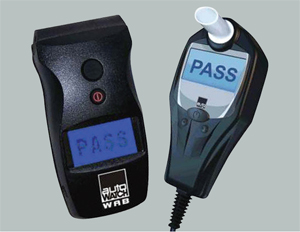If you've had too much alcohol, your vehicle won't start.
 The European Parliament (EP) has made recommendations that call for alcolocks to be mandatory for all new types of commercial passenger and goods vehicles.
The European Parliament (EP) has made recommendations that call for alcolocks to be mandatory for all new types of commercial passenger and goods vehicles.
The most widely used alcolock technology is a device connected to the vehicle ignition which uses an electrochemical fuel cell to detect the Blood Alcohol Concentration (BAC) of a driver who exhales into the mouthpiece. If the BAC exceeds the configured limit the device will not allow the engine to start.
To prevent attempts to defraud the technology by getting another person to breathe into the device, technology has been developed that requires repeat breath samples at random intervals after the engine has been started. If not given, or if the sample exceeds the BAC limit, the device will log the event and warnings will sound until the ignition is turned off. However, it will not simply turn off the engine if an acceptable sample is not given, since this could prove dangerous in traffic.
Devices need to be recalibrated typically at 30, 60 or 90 day intervals which costs around $75 (euro 60) a month in the USA. However some devices in the EU now only require calibration every six months. The price for an alcolock is estimated to be about euro 1,500. With mass production the European Transport Safety Council estimates that the cost could drop to around euro 300-500.
Concerns have been voiced about the accuracy of the equipment, the practicality of use when a driver is required to make frequent drops, and the relative ease with which it might be possible to fool the system by getting another member of the crew to provide the breath sample.
The report (European Parliament resolution of 27 September, 2011 on European road safety 2011-2020) also suggests that the BAC limit should be harmonised across Europe and that there should be a zero limit for professional drivers. It does not, however, state how many accidents are caused by commercial vehicle drivers who are drunk.
The report also calls for common standards for tyres; the possible compulsory fitting of fatigue warning equipment in cabs; bans on lorries overtaking on dangerous stretches of motorways; better road design; the development of skid-resistant road surfaces; a Europe-wide ban on devices that warn drivers of traffic checks and speed cameras, and much more. Read the whole report at http://www.europarl.europa.eu/sides/getDoc.do?type=TA&language=EN&reference=P7-TA-2011-0408.
 How It Works
How It Works
- The driver blows into the alcohol sensor to verify that he is under the legal limit, which will release the immobiliser allowing the vehicle to start.
- Drivers who are over the legal limit will be prevented from starting their vehicles.
- The sensor can be configured to lock out or allow multiple re-tests to release the immobiliser thus allowing a driver to wait until his blood alcohol level drops and blow into the sensor again.
- If the re-test feature is selected then at pre-defined intervals the system will require a new breath sample to be provided. This ensures that drivers are re-tested at random while on route.
- All sample information and failures are stored in a non-volatile memory with date and time stamp.
- If a failure occurs this can be automatically communicated if the optional GSM module is connected.